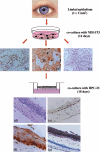Epithelial stem cells of the eye surface
- PMID: 17635514
- PMCID: PMC6495997
- DOI: 10.1111/j.1365-2184.2007.00450.x
Epithelial stem cells of the eye surface
Abstract
Objectives: Epithelial stem cells of the eye surface, of the cornea and of the conjunctiva, have the ability to give rise to self renewal and progeny production of differentiated cells with no apparent limit. The two epithelia are separated from each other by the transition zone of the limbus. The mechanisms adopted by stem cells of the two epithelia to accomplish their different characteristics, and how their survival, replacement and unequal division that generates differentiated progeny formation are controlled, are complex and still poorly understood. They can be learned only by understanding how stem cells/progenitors are regulated by their neighbouring cells, that may themselves be differently unspecialised, forming particular microenvironments, known as 'niches'. Stem cells operate by signals and a variety of intercellular interactions and extracellular substrates with adjacent cells in the niche. Technical advances are now making it possible to identify zones in the corneal limbus and conjunctiva that can house stem cells, to isolate and expand them ex vivo and to control their behaviour creating optimal niche conditions. With improvements in biotechnology, regenerative cornea and conjunctiva transplantation using adult epithelial stem cells becomes now a reality.
Results and conclusions: Here we review our current understanding of stem cell niches and illustrate recent significant progress for identification and characterization of adult epithelial stem cells/progenitors at cellular, molecular and mechanistic levels, improvement in cell culture techniques for their selective expansion ex vivo and prospects for a variety of therapeutic applications.
Figures

Similar articles
-
Human corneal epithelial subpopulations: oxygen dependent ex vivo expansion and transcriptional profiling.Acta Ophthalmol. 2013 Jun;91 Thesis 4:1-34. doi: 10.1111/aos.12157. Acta Ophthalmol. 2013. PMID: 23732018
-
Limbal stem cells of the corneal epithelium.Surv Ophthalmol. 2000 Mar-Apr;44(5):415-25. doi: 10.1016/s0039-6257(00)00109-0. Surv Ophthalmol. 2000. PMID: 10734241 Review.
-
Epithelial stem cells: the eye provides a vision.Eye (Lond). 2003 Nov;17(8):937-42. doi: 10.1038/sj.eye.6700575. Eye (Lond). 2003. PMID: 14631400 Review.
-
Localization of candidate stem and progenitor cell markers within the human cornea, limbus, and bulbar conjunctiva in vivo and in cell culture.Anat Rec A Discov Mol Cell Evol Biol. 2006 Aug;288(8):921-31. doi: 10.1002/ar.a.20346. Anat Rec A Discov Mol Cell Evol Biol. 2006. PMID: 16779811
-
Distribution of label-retaining cells in the limbal epithelium of a mouse eye.J Histochem Cytochem. 2009 Feb;57(2):177-85. doi: 10.1369/jhc.2008.952390. Epub 2008 Nov 11. J Histochem Cytochem. 2009. PMID: 19001638 Free PMC article.
Cited by
-
Autoradiographic study on the regenerative capability of the epithelium lining the center of the cornea after multiple debridements of its peripheral region.Graefes Arch Clin Exp Ophthalmol. 2010 Aug;248(8):1137-44. doi: 10.1007/s00417-010-1368-z. Epub 2010 Apr 1. Graefes Arch Clin Exp Ophthalmol. 2010. PMID: 20358217
-
An Update on Ocular Surface Epithelial Stem Cells: Cornea and Conjunctiva.Stem Cells Int. 2015;2015:601731. doi: 10.1155/2015/601731. Epub 2015 Jun 4. Stem Cells Int. 2015. PMID: 26146504 Free PMC article. Review.
-
Characterization of ocular surface epithelial and progenitor cell markers in human adipose stromal cells derived from lipoaspirates.Invest Ophthalmol Vis Sci. 2012 Jan 31;53(1):513-20. doi: 10.1167/iovs.11-7550. Invest Ophthalmol Vis Sci. 2012. PMID: 22199247 Free PMC article.
-
Low-oxygen culture conditions extend the multipotent properties of human retinal progenitor cells.Tissue Eng Part A. 2014 May;20(9-10):1465-75. doi: 10.1089/ten.TEA.2013.0361. Epub 2014 Jan 24. Tissue Eng Part A. 2014. PMID: 24320879 Free PMC article.
-
Intraocular methotrexate for epithelial downgrowth: long-term outcomes in a multicentre case series.Br J Ophthalmol. 2023 Sep;107(9):1383-1389. doi: 10.1136/bjophthalmol-2022-321168. Epub 2022 Jun 1. Br J Ophthalmol. 2023. PMID: 35649694 Free PMC article.
References
-
- Alison MR (2003) Tissue‐based stem cells: ABC transporter proteins take centre stage. J. Pathol. 200, 553–560. - PubMed
-
- Ambati BK, Nozaki M, Singh N, Takeda A, Jani PD, Suthar T, Albuquerque RJ, Richter E, Sakurai E, Newcomb MT, Kleinman ME, Caldwell RB, Lin Q, Ogura Y, Orecchia A, Samuelson DA, Agnew DW, St Leger J, Green WR, Mahasreshti PJ, Curiel DT, Kwan D, Marsh H, Ikeda S, Leiper LJ, Collinson JM, Bogdanovich S, Khurana TS, Shibuya M, Baldwin ME, Ferrara N, Gerber HP, De Falco S, Witta J, Baffi JZ, Raisler BJ, Ambati J (2006) Corneal avascularity is due to soluble VEGF receptor‐1. Nature 7114, 993–997. - PMC - PubMed
-
- Buschke W (1949) Morphologic changes in cells of corneal epithelium in wound healing. Arch. Ophthalmol. 41, 306–316. - PubMed
Publication types
MeSH terms
Substances
LinkOut - more resources
Full Text Sources
Medical

